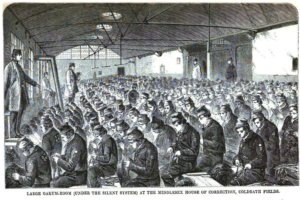Prisoners employed in manufacturing constitute 4.2% of total U.S. manufacturing employment in 2005; they produce cheap goods, creating labor demand shock.
I study the economic externalities of convict labor on local labor markets and firms. Using newly collected panel data on U.S. prisons and convict-labor camps from 1886 to 1940, I calculate each county’s exposure to prisons. I exploit quasi-random variation in county’s exposure to capacities of pre-convict-labor prisons as an instrument. I find that competition from cheap prison-made goods led to higher unemployment, lower labor-force participation, and reduced wages (particularly for women) in counties that housed competing manufacturing industries. The introduction of convict labor accounts for 0.5 percentage-point slower annual growth in manufacturing wages during 1880– 1900. At the same time, affected industries had to innovate away from the competition and thus had higher patenting rates. I also document that technological changes in affected industries were capital-biased.


